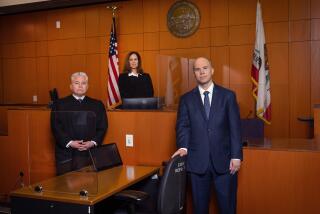Pulling the Plug Won’t Cool Off Trial Coverage
- Share via
America loved its murder trials long before television, devouring news about them with an insatiable appetite.
And, like eager chefs--more accurately, short-order cooks--we in the press have generously served the country what it wanted, garnishing the fare with every sensational trimming.
I don’t know whether this historical view will be of any help to Superior Court Judge Lance A. Ito as he decides whether to carry out his threats to cool down coverage of the O.J. Simpson murder trial by banning TV cameras from the courtroom.
I doubt it. Ito seems harried, having been suddenly thrust into the media maw, transformed from an obscure but respected jurist to the object of Howard Stern’s jokes.
Ito was certainly impatient this week when he yanked the Los Angeles Daily News’ courtroom press pass because the paper obtained and published the jury questionnaire a day before the judge released it. Elevating this bit of journalistic enterprise to the level of the Pentagon Papers, Judge Ito said he considered the paper’s possession of the questionnaire a felony theft of a court document.
But what’s really making Ito mad is television. News leaks infuriate him. So have television stations that broadcast pictures of jurors. The judge blew up after KNBC’s erroneous report about blood tests on a sock. Ever since that incident, Ito has been considering banning live television coverage of the trial.
I’d like to give the judge some advice: It wouldn’t do any good.
*
Newspaper and radio reporters swarmed over the great trials of the pre-television era. City editors screamed at their reporters for exclusives for the many extra editions the papers used to put out during big trials. A reporter who bothered one of those old-time city editors with questions of good taste or ethical practice would have been fired on the spot.
Since early in the century, cameramen were allowed in the courtroom and everyone knew they were there. They lighted their shots with flash powder that sounded and smelled like a small explosive charge. In the ‘20s, the electronic media became just as visible. Radio broadcast the Scopes “Monkey Trial” of a Tennessee teacher charged with violating the state’s law against teaching evolution.
So out of control was the press during the 1937 trial of Bruno Hauptmann for the kidnaping and murder of the Lindbergh baby that judges and lawyers agreed to kick cameras and radio out of the courtroom, a ban that didn’t begin to lift until the ‘70s.
The definitive trial, as far as outrageous news coverage, occurred when television was an infant.
In 1955, Dr. Samuel Sheppard, a Cleveland osteopath, was tried and convicted of the murder of his pregnant wife, Marilyn. Sheppard said he was innocent and that the murder was done by a “form” with whom he struggled before being knocked unconscious. We know the “form” as the “one-armed man,” the villain of the movie and television series “The Fugitive, “ inspired by the Sheppard story.
The Supreme Court overturned the verdict because of “massive, pervasive and prejudicial publicity.” Sheppard was acquitted in a second trial in 1966. The lawyer who represented him before the Supreme Court and in the second trial was F. Lee Bailey, today a member of the Simpson defense team.
It took Justice Tom Clark several pages of the Supreme Court decision to detail all the abuses committed by the media. But for the most part, it was the newspapers, not television, that he criticized.
“Quit Stalling, Bring Him In,” was the headline over one editorial. “Doctor Balks at Lie Test,” proclaimed a headline. While the jury was being selected, a two-inch headline asked “But Who Will Speak for Marilyn?” A leak resulted in a story saying “The prosecution has a bombshell witness on tap who will testify to Dr. Sam’s display of fiery temper.” Walter Winchell reported during the trial that a woman under arrest for robbery in New York City had been Sheppard’s mistress and mother of his child.
*
I know a lot of people think the Simpson trial is soap opera trash and shouldn’t be televised. A thousand of columnist Mike Royko’s readers sent Judge Ito letters to that effect.
Most of them probably watch the trial like mad anyway. They can’t get enough of it. They’re the kind of people who claim to watch PBS while never missing Oprah or an episode of “Days of Our Lives.”
Their hypocrisy aside, I hope Judge Ito doesn’t follow their advice. That’s because of Los Angeles’ experience with another trial, this one from our recent history.
The second trial of the police officers accused of beating Rodney G. King, held in Los Angeles federal court, was not televised. Nevertheless, it turned into a dangerous media circus.
With cameras banned from the courtroom, news came from defense attorneys who briefed the press in unruly news conferences outside the Edward R. Roybal Federal Building. Sometimes a few of the lawyers tried to be straight, but mostly the attorneys feverishly pitched their versions of what happened in the courtroom.
Print and broadcast reporters in the courtroom came out with reports trying to give both sides of the story, but on the news, the pictures were of lawyers giving their accounts.
The city, the memory of the 1992 riots vivid, was tense through the trial. Second-hand accounts of the courtroom proceedings heated up the atmosphere even more. Live coverage might have countered this, focusing attention on the testimony and evidence rather than on the lawyers’ often superheated rhetoric.
Judge Ito, don’t pull the plug.
More to Read
Sign up for Essential California
The most important California stories and recommendations in your inbox every morning.
You may occasionally receive promotional content from the Los Angeles Times.










